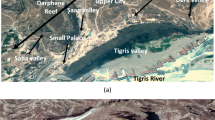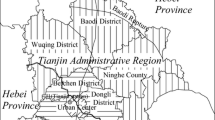Abstract
This study demonstrates the use of geophysics in the field of archaeology not for archaeological exploration but for site assessment and mitigation of degraded archaeological sites because of rough environmental or cultural hazards. Accelerated deterioration of the stone foundations of many temples and monuments at Luxor, Egypt has been documented and is causing global concern for their long-term safety and serviceability. These stone foundations appear to be degrading due to the rise in level and increase in salinity of groundwater. Groundwater transported into the stone foundations by capillary rise through the underlying soil is thought to cause a loss of cohesion and rigidity of these foundations. Moreover, the capillary waters deliver salts into the stone foundations. Pressure developed during crystallization and hydration of these salts exfoliates the outer layers of the stone foundations, allowing them to be easily eroded by wind and other physical processes. The rise in level and increase in salinity of groundwater is thought to be the main problem behind the antiques degradation scenario. We conducted integrated geophysical survey in the form of resistivity and seismic refraction and collected surface water samples for chemical analysis in order to determine the reasons of rise in level and increase in salinity of groundwater. The results showed groundwater is flowing from the east toward the temples area and the groundwater salinity is increasing in the direction of groundwater flow. Our proposed solution is to interrupt or reverse the groundwater flow to stop rise in level and increase in salinity of groundwater.
Access this chapter
Tax calculation will be finalised at checkout
Purchases are for personal use only
Similar content being viewed by others
References
Baines J, Malek J (1980) Cultural atlas of ancient Egypt. Andromeda Oxford, Oxford
Behlen A, Steiger M, Dannecker W (1997) Quantification of the salt input by wet and dry deposition on a vertical masonry. In: Moropoulou A (ed) Fourth international symposium on the conservation of monuments in the Mediterranean Basin. Technical Chamber of Greece, Rhodes, pp 237–246
Charola AE, Herodotus (2000) Salts in the deterioration of porous materials: an overview. J Am Inst Conserv 39(3): Article 2, 327–343
El Hosary MM (1994) Hydrogeological and hydrochemical studies on Luxor area, Southern Egypt. MSc thesis. Ain Shams University, Cairo, Egypt
Kamil J (1989) Luxor: a guide to ancient Thebes, 3rd edn. Longman, London
Sauck WA (1990) Modification of the SCHLINV Program. Internal report. Institute for Water Sciences, Western Michigan University, Kalamazoo
Sevi A (2002) Geotechnical investigation of sandstone degradation of antiquities in Luxor, Egypt. MSc thesis. University of Missouri-Rolla, Rolla
Sowers GB, Sowers GF (1970) Introductory soil mechanics and foundations. Macmillan, New York
Strudwick N, Strudwick H (1999) A guide to the ancient tombs and temples of ancient Luxor, Thebes in Egypt. Cornell University Press, Ithaca
Zohdy AAR, Bisdorf RJ (1989) Programs for the automatic processing and interpretation of Schlumberger sounding curves in QuickBASIC 4.0. U.S. Geological Survey, open-file report, 89-137 A and B
Author information
Authors and Affiliations
Corresponding author
Editor information
Editors and Affiliations
Rights and permissions
Copyright information
© 2019 Springer International Publishing AG, part of Springer Nature
About this chapter
Cite this chapter
Ismail, A. (2019). Geophysical Assessment and Mitigation of Degraded Archaeological Sites in Luxor Egypt. In: El-Qady, G., Metwaly, M. (eds) Archaeogeophysics. Natural Science in Archaeology. Springer, Cham. https://doi.org/10.1007/978-3-319-78861-6_12
Download citation
DOI: https://doi.org/10.1007/978-3-319-78861-6_12
Published:
Publisher Name: Springer, Cham
Print ISBN: 978-3-319-78860-9
Online ISBN: 978-3-319-78861-6
eBook Packages: Social SciencesSocial Sciences (R0)




